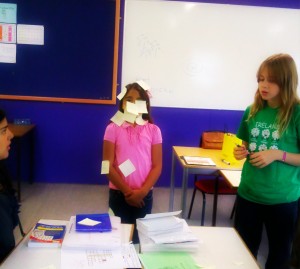What I learned from young learners
I have little experience with teaching young kids but I think this could be the reason why teaching them from time to time is such a joy for me — a time when I learn a lot more about learning than about teaching — a place where I learn about the nature of the learner inside everyone of us. From working with children, I learn great lessons that I then bring to the teaching of teenagers and adults — who approach learning from almost the opposite end of the spectrum than kids do.
Here are three things I’ve learned from kids about learning — things that also explain why kids learn more easily than adults do and why it is good to remember as adult learners, too.
Mindfulness
Probably one of the most amazing things kids have taught me is the importance of mindfulness. It is something we adults, need to learn again. Watch a child in whatever activity he or she is doing. You will probably notice they do not believe in the concept of multitasking — a concept so popular (and damaging) among adults. When they build a sand castle, their minds wander from little towers, gates to water dams. When they draw, they can hardly focus on more than what they hold in their little hands, one colour at a time! When they listen to your story, they imagine every single word you say. And when they don’t, they go and do something else. They stop when they are not interested or attentive. As a teacher, you know that is why you need to change activities very often to keep kids active and interested. Engaged brains learn naturally!
Trust
Teaching kids leaves me with a greater feeling of responsibility. Don’t get me wrong please. I am a responsible teacher with every student no matter what their age is but kids themselves can make you feel that way. They come, sit and wait for what you tell them and yes, they misbehave and do things you don’t ask them to do but they trust you as a teacher — as a person who cares about them — and they accept you know a thing or two they don’t. With adult learners it is not always easy when it comes to trust. It is not easy with teenagers either but they are in a bit different category – a category I love most of all by the way. The problem is that the minds of adult learners is that they are have been so influenced by all the books, methods, friends’ experiences and their own ideas that they wind up overwhelmed by their expectations and doubts about how you should teach them. They often think they know better than you do what they want and need, and they forget you may know better how to get where they want to go or at least trust enough that you will do your best to show them the door that will help them get there. Working with kids is very different because they are very different. If only adults could be more like this: more trusting.
Creativity
You will probably agree with me when I say that every child is creative. However, I believe every person, child or adult, is creative! Kids’ lives are a manifestation of creativity. Adults chase creativity as if it was something they can only find somewhere outside themselves. It is our fear of what others may think or say that stops us from seeing that creative element we carry inside ourselves. You know you’ve found it when you do something with joy and are not thinking too much about the judgment of others. This is what I was writing about recently when I wrote in a recent iTDi blog post that there is an artist living inside every one of us. Look again at how kids draw, write or play. They observe the world; they try to express it as precisely as possible but still through their own eyes and other senses. Later on as they get older, we tell them to stay within the lines when they write, and not to go beyond the margins or do not draw dragons on the edge of their notebooks. Because they trust us, they follow such instructions. As a teacher of adults, don’t be afraid to go back and tell your adult students to draw the flower where there should be a word or paste a piece of paper in their notebook even though it may look messy. Encourage childlike creativity in everyone.
You can only hope they will do things again in their own way, learning in the way that suits them, learning as if it was not compulsory and separated from the rest of their lives — as kids do!




Working with young learners is my favourite thing. The main reason is that state schools and the system have not yet killed that creativity in them and you can do so many things to help them learn.They are not afraid to experiment and try all kinds of activities. They are elephants and tigers, they are firemen and policemen, they are astronauts. I love looking at them while they are drawing – their tongue sticking out on one side, so focused, so into it. You don’t have to tell them why they are doing that activity or why it’s important to say please and thank you. They just want to learn English and be kids at the same time.And I completely agree that creativity is not something that is outside, around us. It’s always there,in every person, but we must not be afraid to show it even when we grow up and become adults. We all have that kid inside even when we’re 30,40… we just have to let that kid play sometimes. If we do that, maybe we will not complain every single day about how hard life is and simply enjoy it.
The category of age I taught most in my teaching career and am still teaching are teens aged between 14 and 18. Like you Vladimira, it’s the category I feel most comfortable and happiest dealing with although it is considered by many the most difficult to teach. I have never taught younger learners and contrary to what many believe, in my opinion, they are the most difficult to handle requiring the greatest teaching skills and expertise in many fields: child psychology and child development come to mind to name only a few in addition to the natural predisposition, the love and the patience to work with kids for so many hours everyday.
I had the opportunity to work with adult beginners and contrary to the general feeling and the positive feedback provided by my adult students about the experience then, I must confess it was not so rewarding to me and feel very reluctant to repeat. I simply couldn’t be myself with them, their filters prevented me from doing it. Having constantly to wear a mask and act less naturally proved very stifling with time. Young learners on the other hand, as you brilliantly pointed out, don’t set barriers to you. They are much easier to reach out by allowing you to be more natural and even being a kid yourself without fearing being judged!
Again, thank you for the wonderful post. Looking forward to reading more from you. Such a great pleasure, really.
Rima
Dear Alex – thank you very much for sharing a bit of your experience and also for not giving up and keeping the child within you happy!
Dear Rima – thank you too for opening your heart to me. And I think you are right about the difficulties of teaching little kids (that is what I meant by the responsibility) 🙂 and thank you very much for reading my posts! 🙂
Great post, Vladimira!
Reading it brought me back to my first steps in teaching and how I also learnt from my little students to be more creative, mindful and … patient. It’s amazing to teach them. They trust you waiting for something interesting and new, ready to be creative and funny, waiting to be encouraged. But you are right they stop when they are not interested or bored with the same (or long) activity.
You encouraged me to write about my lessons with young learners. 🙂
Great ideas dear Vladimira!
Dear Vladimira,
I enjoyed your post because you have focused on children’s naive nature and the realization of: ”one step at a time”. Children trust because they are naive, they are creative because they don’t raise boundaries against their imagination, they focus on one thing each time because at this very moment this is the centre of their interest and perhaps of their whole world.
Adolescents are the in-between age when doubt about everything is starting to built up and they need special handling.
I too usually teach older students. But during the summer, I teach younger students. They are a joy. Their acquisitiveness is awe inspiring. While some of us approach the end and we know it all, these little guys are flowers just budding. One thing that I notice in particular is that young learners are a forgiving sort. If the teacher makes an error, he/she can come back the next day to apologize and continue on the journey. In comparison, older students have learned through conditioning to hold grudges. So, it is refreshing to be around the contagiousness of the young learners’ spirit. Life has so much to give…….pain is not the only component……..there is plenty of love to go around the whole world.
Vladka, thanks for sharing your thoughts.